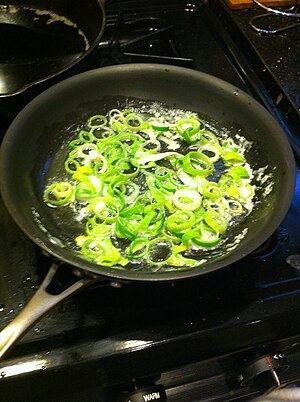ソテー
Sautéing/ja

ソテー(Sautéing or sauteing)(UK: /ˈsoʊteɪɪŋ/、US: /soʊˈteɪɪŋ, sɔː-/; フランス語の「sauté」(fr)に由来し、「跳ねる」「飛び跳ねる」といった意味で、調理中に食材を toss することに言及している。)とは、少量の食用油や油脂を浅い鍋に入れ、比較的高温で加熱する調理法である。様々なソテーの方法が存在する。
概要
ソテーする食材は、通常、調理時間を短縮するために表面積が大きくなるように小さく切るか、薄くスライスされる。ソテーにおける主要な熱伝達様式は、フライパンと調理される食材間の伝導である。ソテーされた食材は、その食感、水分、風味を保ちながら褐色になる。肉、鶏肉、魚をソテーする場合、しばしば、フライパンに残った残留物をデグラッセしてソースを作ることでソテーを仕上げる。
ソテーはパンフライと比較されることがある。パンフライでは、より大きな食材(例:チョップやステーキ)を油や脂で素早く調理し、両面をひっくり返す。一部の料理人は使用する油の深さに基づいて両者を区別するが、他の料理人はこれらの用語を互換的に使用する。
Sautéing differs from searing in that searing only browns the surface of the food.
Certain oils should not be used to sauté due to their low smoke point. Clarified butter, rapeseed oil and sunflower oil are commonly used for sautéing; whatever the fat, it must have a smoke point high enough to allow cooking on medium-high heat, which is the temperature at which sautéing is done. For example, although regular butter would impart more flavor, it would also burn at a lower temperature and more quickly than other fats due to the presence of milk solids. Clarified butter is more fit for this use.
Methods
In a sauté, all the ingredients are heated at once and cooked quickly. To facilitate this, the ingredients are rapidly moved around in the pan, either by the use of a utensil or by repeatedly jerking the pan itself. A sauté pan must be large enough to hold all of the food in one layer, so steam can escape, which keeps the ingredients from stewing and promotes the development of fond. Most pans sold specifically as sauté pans have a wide flat base and low sides, to maximize the surface area available for heating. The low sides allow quick evaporation and escape of steam. While skillets typically have flared or rounded sides, sauté pans typically have straight vertical sides. This keeps the ingredients from escaping as the pan is jerked or stirred.
Only enough fat to lightly coat the bottom of the pan is needed for sautéing; too much fat will cause the food to fry rather than just to slide, and may interfere with the development of fond. The food is spread across the hot fat in the pan, and left to brown, turning or tossing frequently for even cooking. The sauté technique involves gripping the handle of the sauté pan firmly and using a sharp elbow motion to rapidly jerk the pan back toward the cook, repeating as necessary to ensure the ingredients have been thoroughly jumped. Tossing or stirring the items in the pan by shaking the pan too often, however, can cause the pan to cool and make the sauté take longer.
- Sautéing
-
Sautéing onions and peppers
-
Sautéed mushrooms: baby Bella (portobello) mushrooms being sautéed
-
Sautéed vegetables being tossed in a sauté pan
-
Flambéing in a sauté pan
関連項目
外部リンク
 Media related to Sautéing at Wikimedia Commons
Media related to Sautéing at Wikimedia Commons [[wikibooks:Cookbook:Sautéing |]] at the Wikibooks Cookbook subproject
[[wikibooks:Cookbook:Sautéing |]] at the Wikibooks Cookbook subproject
| この記事は、クリエイティブ・コモンズ・表示・継承ライセンス3.0のもとで公表されたウィキペディアの項目Sautéing(19 April 2025, at 19:13編集記事参照)を翻訳して二次利用しています。 |



